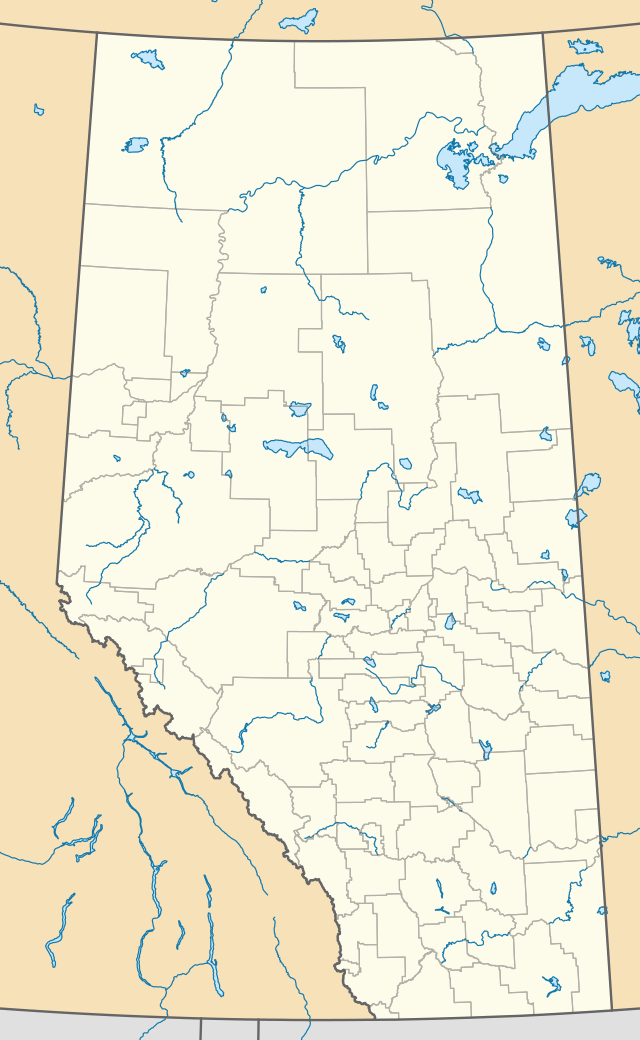Kinuso
Kinuso is a hamlet in northern Alberta, Canada within Big Lakes County,[2] and surrounded by the Swan River First Nation reserve. It is located approximately 48 kilometres (30 mi) west of Slave Lake and 71 km east of High Prairie along Highway 2, south of the southern shore of Lesser Slave Lake.
Kinuso | |
|---|---|
Hamlet | |
.jpg) | |
 Kinuso | |
| Coordinates: 55°19′59″N 115°26′1″W | |
| Country | |
| Province | |
| Region | Northern Alberta |
| Census Division | No. 17 |
| Municipal district | Big Lakes County |
| Government | |
| • Governing body | Big Lakes County Council |
| Area (2011)[1] | |
| • Total | 0.61 km2 (0.24 sq mi) |
| Elevation | 610 m (2,000 ft) |
| Population (2011)[1] | |
| • Total | 276 |
| • Density | 452.0/km2 (1,171/sq mi) |
| Time zone | UTC-7 (MST) |
| Highways | 2 |
| Waterways | Lesser Slave Lake |
The name Kinuso comes from the Cree word kinosew, meaning fish.
Kinuso was incorporated as a village until it dissolved on September 1, 2009.[3]
Demographics
| Year | Pop. | ±% |
|---|---|---|
| 1951 | 238 | — |
| 1956 | 306 | +28.6% |
| 1961 | 323 | +5.6% |
| 1966 | 376 | +16.4% |
| 1971 | 267 | −29.0% |
| 1976 | 305 | +14.2% |
| 1981 | 285 | −6.6% |
| 1986 | 282 | −1.1% |
| 1991 | 230 | −18.4% |
| 1996 | 258 | +12.2% |
| 2001 | 231 | −10.5% |
| 2006 | 219 | −5.2% |
| 2011 | 276 | +26.0% |
| 2016 | 182 | −34.1% |
| Source: Statistics Canada [4][5][6][7][8][9][10][11] | ||
As a designated place in the 2016 Census of Population conducted by Statistics Canada, Kinuso recorded a population of 182 living in 77 of its 102 total private dwellings, a change of -34.1% from its 2011 population of 276. With a land area of 0.59 km2 (0.23 sq mi), it had a population density of 308.5/km2 (798.9/sq mi) in 2016.[11]
In the 2011 Census, Kinuso had a population of 276 living in 109 of its 116 total dwellings, a 26.0% change from its 2006 population of 219. With a land area of 0.61 km2 (0.24 sq mi), it had a population density of 452/km2 (1,172/sq mi) in 2011.[1]
See also
References
- "Census Profile - Kinuso, Village, Alberta (Dissolved census subdivision)". Statistics Canada. 2012-11-02. Retrieved 2012-12-02.
- Alberta Municipal Affairs (2010-04-01). "Specialized and Rural Municipalities and Their Communities" (PDF). Archived from the original (PDF) on 2012-02-29. Retrieved 2010-06-20.
- Alberta Queen’s Printer (2009-07-21). "Order in Council (O.C.) 407/2009". Retrieved 2010-06-20.
- "Table 6: Population by sex, for census subdivisions, 1956 and 1951". Census of Canada, 1956. Volume I: Population. Ottawa: Dominion Bureau of Statistics. 1958.
- "Table 9: Population by census subdivisions, 1966 by sex, and 1961". 1966 Census of Canada. Western Provinces. Population: Divisions and Subdivisions. Ottawa: Dominion Bureau of Statistics. 1967.
- "Table 3: Population for census divisions and subdivisions, 1971 and 1976". 1976 Census of Canada. Census Divisions and Subdivisions, Western Provinces and the Territories. Population: Geographic Distributions. Ottawa: Statistics Canada. 1977.
- "Table 2: Census Subdivisions in Alphabetical Order, Showing Population Rank, Canada, 1981". 1981 Census of Canada. Census subdivisions in decreasing population order. Ottawa: Statistics Canada. 1982. ISBN 0-660-51563-6.
- "Table 2: Population and Dwelling Counts, for Census Divisions and Census Subdivisions, 1986 and 1991 – 100% Data". 91 Census. Population and Dwelling Counts – Census Divisions and Census Subdivisions. Ottawa: Statistics Canada. 1992. pp. 100–108. ISBN 0-660-57115-3.
- "Population and Dwelling Counts, for Canada, Provinces and Territories, and Census Divisions, 2001 and 1996 Censuses – 100% Data (Alberta)". Statistics Canada. Retrieved 2019-05-25.
- "Population and dwelling counts, for Canada, provinces and territories, and census subdivisions (municipalities), 2006 and 2001 censuses – 100% data (Alberta)". Statistics Canada. January 6, 2010. Retrieved 2019-05-25.
- "Population and dwelling counts, for Canada, provinces and territories, and designated places, 2016 and 2011 censuses – 100% data (Alberta)". Statistics Canada. February 8, 2017. Retrieved February 13, 2017.